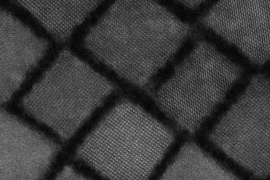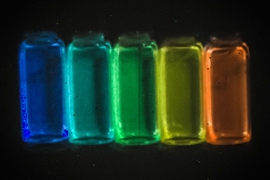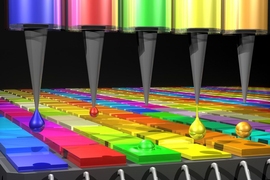In the global quest to develop practical computing and communications devices based on the principles of quantum physics, one potentially useful component has proved elusive: a source of individual particles of light with perfectly constant, predictable, and steady characteristics. Now, researchers at MIT and in Switzerland say they have made major steps toward such a single photon source.
The study, which involves using a family of materials known as perovskites to make light-emitting particles called quantum dots, appears today in the journal Science. The paper is by MIT graduate student in chemistry Hendrik Utzat, professor of chemistry Moungi Bawendi, and nine others at MIT and at ETH in Zurich, Switzerland.
The ability to produce individual photons with precisely known and persistent properties, including a wavelength, or color, that does not fluctuate at all, could be useful for many kinds of proposed quantum devices. Because each photon would be indistinguishable from the others in terms of its quantum-mechanical properties, it could be possible, for example, to delay one of them and then get the pair to interact with each other, in a phenomenon called interference.
“This quantum interference between different indistinguishable single photons is the basis of many optical quantum information technologies using single photons as information carriers,” Utzat explains. “But it only works if the photons are coherent, meaning they preserve their quantum states for a sufficiently long time.”
Many researchers have tried to produce sources that could emit such coherent single photons, but all have had limitations. Random fluctuations in the materials surrounding these emitters tend to change the properties of the photons in unpredictable ways, destroying their coherence. Finding emitter materials that maintain coherence and are also bright and stable is “fundamentally challenging,” Utzat says. That’s because not only the surroundings but even the materials themselves “essentially provide a fluctuating bath that randomly interacts with the electronically excited quantum state and washes out the coherence,” he says.
“Without having a source of coherent single photons, you can’t use any of these quantum effects that are the foundation of optical quantum information manipulation,” says Bawendi, who is the Lester Wolfe Professor of Chemistry. Another important quantum effect that can be harnessed by having coherent photons, he says, is entanglement, in which two photons essentially behave as if they were one, sharing all their properties.
Previous chemically-made colloidal quantum dot materials had impractically short coherence times, but this team found that making the quantum dots from perovskites, a family of materials defined by their crystal structure, produced coherence levels that were more than a thousand times better than previous versions. The coherence properties of these colloidal perovskite quantum dots are now approaching the levels of established emitters, such as atom-like defects in diamond or quantum dots grown by physicists using gas-phase beam epitaxy.
One of the big advantages of perovskites, they found, was that they emit photons very quickly after being stimulated by a laser beam. This high speed could be a crucial characteristic for potential quantum computing applications. They also have very little interaction with their surroundings, greatly improving their coherence properties and stability.
Such coherent photons could also be used for quantum-encrypted communications applications, Bawendi says. A particular kind of entanglement, called polarization entanglement, can be the basis for secure quantum communications that defies attempts at interception.
Now that the team has found these promising properties, the next step is to work on optimizing and improving their performance in order to make them scalable and practical. For one thing, they need to achieve 100 percent indistinguishability in the photons produced. So far, they have reached 20 percent, “which is already very remarkable,” Utzat says, already comparable to the coherences reached by other materials, such as atom-like fluorescent defects in diamond, that are already established systems and have been worked on much longer.
“Perovskite quantum dots still have a long way to go until they become applicable in real applications,” he says, “but this is a new materials system available for quantum photonics that can now be optimized and potentially integrated with devices.”
It’s a new phenomenon and will require much work to develop to a practical level, the researchers say. “Our study is very fundamental,” Bawendi notes. “However, it’s a big step toward developing a new material platform that is promising.”
The work was supported by the U.S. Department of Energy, the National Science Foundation, and the Swiss Federal Commission for Technology and Innovation.












